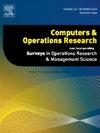Bilevel competitive facility location and design under a nested logit model
IF 4.3
2区 工程技术
Q2 COMPUTER SCIENCE, INTERDISCIPLINARY APPLICATIONS
引用次数: 0
Abstract
This paper investigates a competitive facility location problem involving two companies entering a market. Both aim to locate and design new facilities to maximize revenue. The decision-making process involves one company acting as the “leader” making the initial decision, and the other as the “follower”, observing the leader’s decision before making its own. Customers choose between the two companies’ facilities based on a nested logit model (NLM). In our model, facilities are grouped into two categories to reflect similarities within each company’s facilities, resulting in a two-nest NLM. We aim to determine the optimal decision for the leader, considering the follower’s potential responses and customer preferences as dictated by the NLM. To solve this problem, we develop a nonlinear 0–1 bilevel program and propose an exact solution algorithm with two bounding problems and specialized branch-and-cut subroutines. The algorithm is guaranteed to converge to an optimal pessimistic bilevel solution in a finite number of iterations. Extensive computational experiments using a common testbed from existing literature validate our algorithm’s efficiency. Additionally, we conduct sensitivity analysis to examine the impact of NLM parameters on strategic location decisions and compare our NLM-based model with a multinomial logit model (MNL)-based model. Our findings show that using NLM over MNL can prevent potential revenue losses. Specifically, if the actual decision context is better represented by NLM but MNL is used by the leader, then the leader could face significant revenue decreases, up to 30.44%.
嵌套logit模型下的双层竞争设施选址与设计
本文研究了一个涉及两家公司进入同一市场的竞争性设施选址问题。两者的目标都是定位和设计新的设施,以实现收入最大化。在决策过程中,一家公司作为“领导者”做出最初的决定,另一家公司作为“追随者”,在做出自己的决定之前观察领导者的决定。客户根据嵌套logit模型(NLM)在两家公司的设施之间进行选择。在我们的模型中,设施被分为两类,以反映每个公司设施内部的相似性,从而产生双巢NLM。我们的目标是确定领导者的最佳决策,考虑到追随者的潜在反应和客户偏好,由NLM决定。为了解决这一问题,我们开发了一个非线性0-1双层规划,并提出了一个具有两个边界问题和专门的分支切断子程序的精确解算法。该算法保证在有限次迭代中收敛到最优悲观二层解。利用现有文献中的通用测试平台进行了大量的计算实验,验证了算法的有效性。此外,我们还进行了敏感性分析,以检验NLM参数对战略选址决策的影响,并将基于NLM的模型与基于多项logit模型(MNL)的模型进行了比较。我们的研究结果表明,使用NLM而不是MNL可以防止潜在的收入损失。具体而言,如果实际的决策语境由NLM更好地代表,但领导者使用MNL,那么领导者可能面临显著的收入下降,最高可达30.44%。
本文章由计算机程序翻译,如有差异,请以英文原文为准。
求助全文
约1分钟内获得全文
求助全文
来源期刊

Computers & Operations Research
工程技术-工程:工业
CiteScore
8.60
自引率
8.70%
发文量
292
审稿时长
8.5 months
期刊介绍:
Operations research and computers meet in a large number of scientific fields, many of which are of vital current concern to our troubled society. These include, among others, ecology, transportation, safety, reliability, urban planning, economics, inventory control, investment strategy and logistics (including reverse logistics). Computers & Operations Research provides an international forum for the application of computers and operations research techniques to problems in these and related fields.
 求助内容:
求助内容: 应助结果提醒方式:
应助结果提醒方式:


